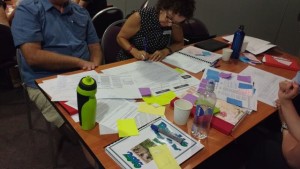Open Learning Through Improvement Science Partnerships
 What Is Improvement Science?
What Is Improvement Science?
Taking its inspiration from the work of management expert W.E. Deming, Improvement Science is a powerful set of processes that enable practitioners – in increasingly wide-ranging fields – to get better at getting better. It places the responsibility for knowledge gathering, and understanding how systems can improve (back) into the hands of practitioners. It’s been shown to be effective at crossing boundaries, with impressive rates of adoption in the automotive and aviation industries, healthcare, sport, and more recently, education.
Improvement Science is not a one-off attempt to innovate. Nor does it offer ‘radical disruption’. It should rather be seen as a continuous quality improvement process, based upon rapid cycles of often small change actions that practitioners themselves (not external researchers or consultants) Plan, Do, Study (and then further) Act (Deming’s PDSA cycle). Though not aimed at radical disruption, if enough of these cycles are completed, transformative results can be achieved – as demonstrated by Sky’s Cycling Teams “aggregation of incremental gains”. Their aim – of winning the Tour de France within five years – was achieved in only three by the use of improvement science methodology. Similarly, Atul Gawande has described remarkable transformations in healthcare through the use of continuous improvement cycles.
How does it differ from existing approaches?
In both healthcare and education, practitioners have often been disappointed and confused by randomised control trials and other forms of what’s known as ‘experimental science’. Promising early-stage experiments often fail to scale up when inevitable ‘variations’ (of context, of fidelity of implementation) are introduced. ‘What works’ usually only works under specific circumstances, with fidelity to the original implementation, within similar contexts and user groups. Countless pedagogic reforms and medical breakthroughs have experienced disappointment when the messiness of real life intervenes, and “lethal mutations” occur. Unfortunately, Randomised Control Trials, by their definition, don’t work well when systemic factors are introduced.
 Improvement Science, by contrast, embraces variation, encouraging practitioners to understand what happens when their own specific context is applied, and make adjustments accordingly in the next PDSA cycle. It uses practical practitioner-designed measures to assess whether improvement has happened – not validated, empirically tested tools.. Improvement science requires practitioners to understand how changes are affected by the ‘profound knowledge’ contained within organisations, and usually enhances the collective will for improvement as a result. This is one of the key reasons why Improvement Science has crossed disciplinary boundaries so effectively.
Improvement Science, by contrast, embraces variation, encouraging practitioners to understand what happens when their own specific context is applied, and make adjustments accordingly in the next PDSA cycle. It uses practical practitioner-designed measures to assess whether improvement has happened – not validated, empirically tested tools.. Improvement science requires practitioners to understand how changes are affected by the ‘profound knowledge’ contained within organisations, and usually enhances the collective will for improvement as a result. This is one of the key reasons why Improvement Science has crossed disciplinary boundaries so effectively.
How does it work in practice?
Although there are many different lenses to view improvement through, (and therefore many different mechanisms to structure and assess improvements), stripped to its essentials all improvement science attempts to answer three questions:
- What are we trying to accomplish?
- What change can we make that will result in an improvement?
- How will we know that change has effected an improvement?
We have worked with schools engaged in the carnegie Foundation’s Networked Innovation Communities (NICs) to refine our own particular action steps to Improvement Science: practitioners choose the problem to be addressed; identify their aim (in our view, not through target-setting – Deming strongly believed that imposing targets corrupts the process of improvement); find out as much as they can about how end users experience the problem; understand why existing practice falls short of their aim; hypothesise on change actions that might result in improvement; plan PDSA cycles; understand what needs to be measured; implement changes; review, revise and repeat!
How can I train my staff in improvement science?
Educational Arts offers two opportunities (which can be combined for greater impact):
- A two-day intensive introduction to Improvement Science processes. We will work with groups of practitioners to give them a hands-on, thorough grounding in the key steps in effective planning, measuring, assessing and reviewing. We recommend this when there is a whole organisation commitment to improvement science, and an Improvement Science champion/advocate exists within the organisation to ensure that the continuous part of improvement cycles is implemented.
- (Our recommended option) We establish an Improvement Science partnership with an organisation and support them through the entire implementation phase of their first PDSA cycles, until they are sufficiently confident to continue the work without support. This is achieved through initial training, Skype support seminars, deeper-dive surgeries (online and face-to-face) and facilitated review sessions. The partnership is concluded with a report, with recommendations, to senior leadership. Because of the intensity of this process, we recommend that we work with groups of around 12-15 practitioners in each partnership.
Can I expect to see improvement in practice?
Although Improvement Science is in its infancy in education, we believe there is sufficient confidence in case studies so far, to suggest that, implemented with conviction, it will result in steady and continuous improvement. However, an important additional benefit is that the process of applying improvement science in your organisation should result in the generation of a dynamic, open, collaborative learning culture. As David described in ‘OPEN’, this alone will ensure that you have a sustainable competitive advantage, that will contribute to the engagement and loyalty of your staff.
Sounds great, what do I do next?
Please contact us, so that we can discuss your improvement needs and determine the best way forward.
